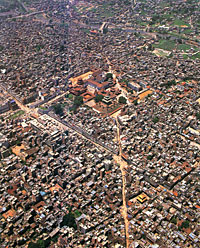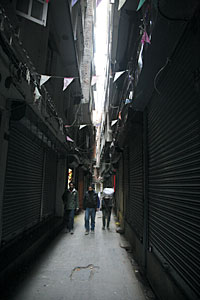 PICS: MIN RATNA BAJRACHARYA |
Last Tuesday's 7.3 Richter earthquake devastated the island nation of Haiti, and alarm bells rang on the other side of the world as it emerged that thousands were dead or missing. There are approximately 1300 Nepali peacekeepers stationed in the country.
They may have been declared safe, but Nepal has plenty of reason to worry on its own account as it prepares for Earthquake Safety Day on January 16. Nepal ranks 11th on the list of nations at risk from earthquakes. Experts note that major earthquakes occur here every 80 to 100 years. The last catastrophe to fit this bill occurred in 1934, when 80,000 houses were destroyed and 8,518 people died in an 8.3 Richter quake, half in the Kathmandu Valley. But preventative measures are proceeding at a snail's pace.
Following the earthquake of 1988, during which 721 people lost their lives, the state did begin to look into such measures. The 2005 Nepal National Building Code was to be enacted in 58 municipalities and 121 peri-urban VDCs in two years. Between 1994 and 2009, 7530 engineers, overseers and masons were trained in earthquake-resistant construction. Similarly, the National Society for Earthquake Technology (NSET) has provided training to 206 members of the security forces and the Red Cross on earthquake impact minimisation.
But implementation is virtually absent. Though Lalitpur, Dharan and Surkhet have enacted the building code, Kathmandu, Bhaktapur, Thimi and Kirtipur have only adopted piecemeal measures. Amrit Man Tuladhar, National Program Manager for the Earthquake Risk Reduction and Recovery Preparedness Programme for Nepal, says, "There are laws, we've provided training, but if it isn't implemented what can we do?"
The problem stems in part from the lack of a separate government authority and national strategy for disaster management, such as exist in many Asian nations. Implementation has also suffered due to weak support from local administration, which in any case is hamstrung by the absence of elected representatives in the last decade.
More recently, the cabinet passed the Disaster Risk Reduction Management National Regulations. Though the regulations were much delayed, NSET National Program Manager Amod Dixit asserts they could play an important role in disaster management. It incorporates the provisions of the 2005 Hyogo Framework for Action (HFA) adopted by 123 nations in Japan, chiefly the formulation of relevant legislation, risk and damage assessments, public awareness and risk reduction measures. Dixit quips, "Easy if you do it, hard if you don't want to."
If the government wants to, the Disaster Risk Reduction Management National Regulations could be passed in parliament and put into action immediately. Shankar Koirala, Joint Secretary of the Central Natural Disaster Relief Committee at the Home Ministry, claims a relevant draft law is almost ready to be submitted to parliament. The enactment of this law, under the aegis of a National Emergency Work Coordination Centre to be set up in Singh Darbar in coordination with multiple state organs, will be a major achievement. But according to Dixit, it will take 20 years for Nepal to reach the level of Japan's preparedness even if the strategy is implemented tomorrow. Time is of the essence.
Capital risk
 |
The situation is similar in the other municipalities of the Kathmandu Valley, though engineer Pravin Shrestha claims in Lalitpur, carpenters have been trained to build earthquake-resistant houses and the municipality does conduct regular checks.
It's not just old residential houses that are at risk: administrative centres such as Singh Darbar are equally insecure. According to NSET estimates, an earthquake on the scale of 1934 could destroy 70 per cent of the Valley's buildings. Eighty per cent of casualties would occur as a result of people being crushed by buildings. With most open spaces here being encroached upon by residential and commercial complexes, the inhabitants of the Valley would have nowhere to go in the event of another earthquake. The human costs are almost unimaginable.
READ ALSO:
Haiti here - FROM ISSUE #485 (15 JAN 2010 - 21 JAN 2010)


